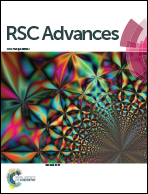Negatively charged gold nanoparticles as a dexamethasone carrier: stability in biological media and bioactivity assessment in vitro†
Abstract
Gold nanoparticles (AuNPs) have been extensively used in biological applications because of their high biocompatibility, ease of characterization and the extensive knowledge of their surface chemistry. These features make AuNPs readily exploitable for drug delivery and novel diagnostic and therapeutic approaches. In a previous work, we showed that small size (5–10 nm) AuNPs functionalized by sodium 3-mercapto-1-propanesulfonate (3MPS) can be efficiently loaded with the glucocorticoid drug dexamethasone (DXM) and are stable in water and PBS. In the present study, we further analysed the stability and the drug release kinetics of DXM-loaded AuNPs functionalized by sodium 3-mercaptopropane sulfonate (AuNP-3MPS/DXM) and their unconjugated counterparts (AuNP-3MPS) in different biological media. Moreover, we evaluated AuNP-3MPS cyto-compatibility on two mammalian cell lines and tested their specific activity as drug carriers on DXM-sensitive murine and human tumor cells. The colloidal stability of AuNP-3MPS/DXM was significantly increased in all tested culture media, compared with the unconjugated AuNP-3MPS and both AuNP-3MPS formulations which proved non-toxic to biological systems in vitro. Most importantly, we showed that AuNP-3MPS/DXM continuously release bioactive DXM molecules that efficiently induce cell proliferation arrest and apoptotic cell death on a human lymphoma cell line and upregulation of the DXM-inducible programmed cell death-1 (PD-1) molecule on activated mouse T lymphocytes. These data confirm that the AuNP-3MPS/DXM conjugate is a promising system for drug delivery and open interesting perspectives for future in vivo applications.



 Please wait while we load your content...
Please wait while we load your content...